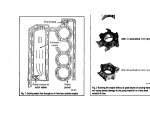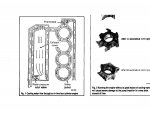arriva2001
Seaman
- Joined
- Feb 15, 2015
- Messages
- 64
Hi
I am wondering if any of you Force outboard owners have any thoughts on the overheat warning sensor.
I have a 1994 Force 150 that I've owned since it was new. I use it several times a year and always have it serviced. I've never had any problems with this engine until the last time it was serviced.
It was getting water in the gear case, so the dealer replaced the seals and while they were at it, replaced the impeller. They also REMOVED the thermostat--with a note on the receipt that the thermostat is not necessary unless in cold water (not sure I agree with this, but I went along with it since it was a mercury/Force service shop)..
I've only used the boat three times since this repair, and I've found that it works fine...I can cruise and pull a tube around all day, but then if I decide to slowdown fior a ride at or around idle speed, the overheat warning goes off.
I immediately shut it down and remove the cowl to air cool so I can start it again. Then after waiting about 10 mins, I can start and run again at full high speed with no issues.
3 questions
1. Is it legit to run without a thermostat, and could this actually be causing the overheat at idle? I plan to replace it myself ( the problem seems too much of a coincidence to ignore) but wondering if the repair shop doesn't know what they are talking about.
2. Other than replacing the impeller and checking for blockages is there anything else I should check or replace to troubleshoot overheat at idle?
3. Does anyone know at what temperature the overheat warning goes off vs. what temperature you actually do engine damage? I'm hoping by shutting down immediately when that sensor went off that I'm going to be ok. I'd hate to think that the warning sensor is more like a "oops you are too late..." sensor. I can't find anything around this online.
The overheat sensor has gone off exactly three times. The first two I thought were due to seaweed clogging intake. But now thinking its impeller. I always immediately decelerated and powered down....so hoping I didn't cause any damage... it's been a good motor for a lot of years (even though I hear a lot of gripes about the Force brand--this ones not caused me any headaches).
Any help would be appreciated!
I am wondering if any of you Force outboard owners have any thoughts on the overheat warning sensor.
I have a 1994 Force 150 that I've owned since it was new. I use it several times a year and always have it serviced. I've never had any problems with this engine until the last time it was serviced.
It was getting water in the gear case, so the dealer replaced the seals and while they were at it, replaced the impeller. They also REMOVED the thermostat--with a note on the receipt that the thermostat is not necessary unless in cold water (not sure I agree with this, but I went along with it since it was a mercury/Force service shop)..
I've only used the boat three times since this repair, and I've found that it works fine...I can cruise and pull a tube around all day, but then if I decide to slowdown fior a ride at or around idle speed, the overheat warning goes off.
I immediately shut it down and remove the cowl to air cool so I can start it again. Then after waiting about 10 mins, I can start and run again at full high speed with no issues.
3 questions
1. Is it legit to run without a thermostat, and could this actually be causing the overheat at idle? I plan to replace it myself ( the problem seems too much of a coincidence to ignore) but wondering if the repair shop doesn't know what they are talking about.
2. Other than replacing the impeller and checking for blockages is there anything else I should check or replace to troubleshoot overheat at idle?
3. Does anyone know at what temperature the overheat warning goes off vs. what temperature you actually do engine damage? I'm hoping by shutting down immediately when that sensor went off that I'm going to be ok. I'd hate to think that the warning sensor is more like a "oops you are too late..." sensor. I can't find anything around this online.
The overheat sensor has gone off exactly three times. The first two I thought were due to seaweed clogging intake. But now thinking its impeller. I always immediately decelerated and powered down....so hoping I didn't cause any damage... it's been a good motor for a lot of years (even though I hear a lot of gripes about the Force brand--this ones not caused me any headaches).
Any help would be appreciated!





















